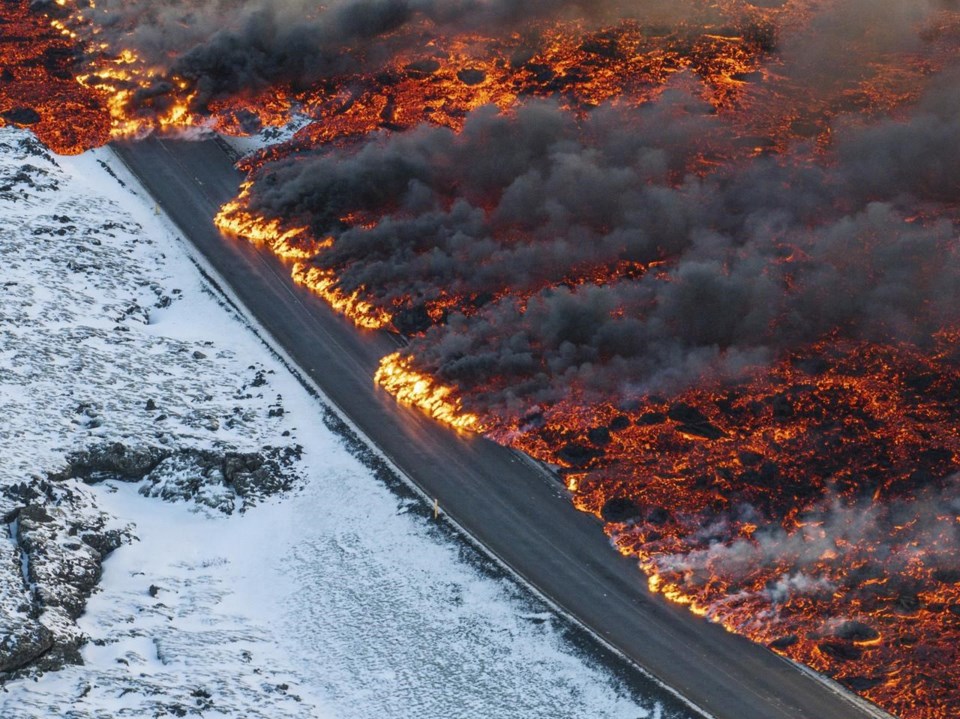GRINDAVIK, Iceland (AP) ÔÇö A volcano in southwestern Iceland erupted Thursday for , sending jets of lava into the sky, triggering the evacuation of the popular Blue Lagoon geothermal spa and cutting heat and hot water to thousands of people.
The eruption began at about 0600 GMT (1 a.m. EST) along a three-kilometer (nearly two-mile) fissure northeast of Mount SÛlingarfell, the Icelandic Meteorological Office said. Several communities on the Reykjanes Peninsula were cut off from heat and hot water after a river of lava engulfed a supply pipeline.
The strength of the eruption had decreased by mid-afternoon, the Met Office said, though lava continued to spew from parts of the fissure and a huge plume of steam rose over a section of the crack where magma mixed with groundwater.
The eruption site is about 4 kilometers (2 1/2 miles) northeast of Grindavik, that was evacuated before on Dec. 18. The Meteorological Office said there was no immediate threat to the town on Thursday.
Civil defense officials said no one was believed to be in Grindavik at the time of the new eruption. ÔÇ£They werenÔÇÖt meant to be, and we donÔÇÖt know about any," V├¡├░ir Reynisson, the head of IcelandÔÇÖs Civil Defense, told national broadcaster RUV.
The Civil Defense agency said lava reached a pipeline that supplies several towns on the Reykjanes Peninsula with hot water ÔÇö which is used to heat homes ÔÇö from the Svartsengi geothermal power plant. Authorities urged residents to use hot water and electricity sparingly, as workers rushed to lay an underground water pipe as a backup. Schools, gyms and swimming pools were shut because of the lack of heat and water.
The Blue Lagoon thermal spa, created using excess water from the power plant, was closed when the eruption began and all the guests were safely evacuated, RUV said. A stream of steaming lava later spread across the exit road from the spa.
No flight disruptions were reported at nearby Keflavik, IcelandÔÇÖs main airport, but hot water was cut off, airport operator Isavia said.
The Icelandic Met Office earlier this week warned of a possible eruption after monitoring a buildup of magma, or semi-molten rock, below the ground for the past three weeks. Hundreds of small earthquakes had been measured in the area since Friday, capped by a burst of intense seismic activity about 30 minutes before the latest eruption began.
Dramatic video from Iceland's coast guard showed fountains of lava soaring more than 50 meters (165 feet) into the darkened skies. A plume of vapor rose about 3 kilometers (1 1/2 miles) above the volcano.
Iceland, which sits above a , averages an eruption every four to five years. The most disruptive in recent times was the 2010 eruption of the Eyjafjallajokull volcano, which spewed huge clouds of ash into the atmosphere and led to widespread airspace closures over Europe.
Dave McGarvie, a volcanologist who has worked extensively in Iceland, said itÔÇÖs highly unlikely the ÔÇ£gentle, effusiveÔÇØ eruption would disrupt aviation because such volcanoes produce only a tiny amount of ash.
Grindavik, about 50 kilometers (30 miles) southwest of IcelandÔÇÖs capital, Reykjavik, was evacuated in November when the Svartsengi volcanic system awakened after almost 800 years with a series of earthquakes that opened large cracks in the earth north of the town.
on Dec. 18, sending lava flowing away from Grindavik. A second eruption that began on Jan. 14 sent lava towards the town. Defensive walls that had been bolstered since the first eruption stopped some of the flow, but several buildings were consumed by the lava, and land in the town has sunk by as much as 1 1/2meters (4 1/2 feet) because of the magma movement.
No confirmed deaths have been reported, but a workman is missing after falling into a fissure opened by the volcano.
Both the previous eruptions lasted only a matter of days, but they signal what Icelandic President Gudni Th. Johannesson called ÔÇ£a daunting period of upheavalÔÇØ on the Reykjanes Peninsula, one of the most densely populated parts of Iceland.
ItÔÇÖs unclear whether the residents of Grindavik will ever be able to return permanently, McGarvie said.
ÔÇ£I think at the moment there is the resignation, the stoical resignation, that, for the foreseeable future, the town is basically uninhabitable,ÔÇØ he said.
He said that after centuries of quiet, ÔÇ£people thought this area was fairly safe.ÔÇØ
ÔÇ£ItÔÇÖs been a bit of a shock that it has come back to life," he added, ÔÇ£Evidence that we gathered only quite recently is that eruptions could go on for decades, if not centuries, sporadically in this particular peninsula.ÔÇØ
___
Danica Kirka and Jill Lawless in London contributed to this story.
Marco Di Marco, The Associated Press



